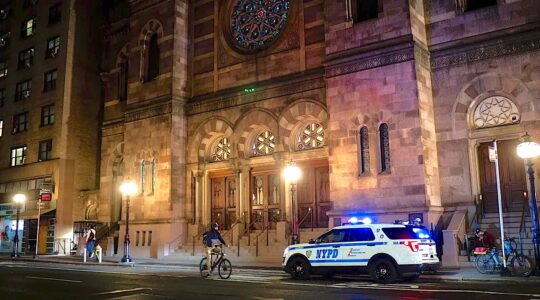Enter the room that houses Miriam Stern’s installation piece “Ezrat Nashim” and you’ll be struck by the clusters of women’s figures, 10 in all, standing together in a corner, like oversized paper dolls covered in earth-tone designs.
Ezrat Nashim refers to the women’s section, the space in the sanctuaries of Orthodox synagogues designated for women. Most, as Stern tells The Jewish Week in an interview at the Yeshiva University Museum, where the show is on view, are located “back in a corner somewhere.” As Stern, a painter and printmaker who has exhibited her work throughout the U.S. and in Israel, explains, “Although women and men participate in the services, mostly quietly and individually, they are not part of the same spiritual and communal activity that takes place in the main space of the synagogue, the men’s side.”
Stern’s women, arranged in a loose assemblage of rows so that viewers can walk among them, are two-sided: For each, the side facing the entrance is covered with an enlarged photograph of a particular mechitza, the partition that divides women’s and men’s sections and creates distinct realms. The patterns appear in shades of brown, beige and gray. From the other side, the women’s personality is evident, as Stern has painted something representational about them, in bright colors, onto the aluminum.
Stern’s mechitzas are made of plywood, Plexiglas, lattice or lace, materials of different qualities. Depending on the material and the light, a divider might be more or less transparent, more or less aesthetically pleasing. The different mechitzas create varying degrees of perceived separation. Stern photographed synagogues in Bergen County, N.J., and in Jerusalem to create these images, fitted carefully, sometimes playfully, to each woman. One woman seems to have a tuck of lace around her neck like a scarf.
The women look as they might appear to someone looking at them through the mechitza: their shape, their presence is defined by the mechitza. On their flip painted sides, the women are no longer anonymous. They actually represent nine of Stern’s friends; the 10th is a self-portrait of the artist, who depicts her ongoing efforts to balance her roles as artist, wife and mother.
These are strong, accomplished women who know who they are: a psychotherapist who does biblical interpretation, a publisher, a friend who always rolls out the red carpet for others. A few are artists, and a successful interior designer is shown with golden hands. Their skirt lengths vary; they wear high heels, clogs and sensible shoes.
The silhouettes bring to mind paper dolls on stands, which Stern says she loved playing with as a child. She comments, “I’m still playing.”
The sound of women’s prayers fills the room. Stern and several of the women are recorded chanting the Hallel, psalms of praise, that are said on rosh chodesh, the new month, which is traditionally a women’s holiday. Their voices are soft and sweet. Stern said that she didn’t want the music to sound professional, as “we’re ordinary women.” Stern says that she has heard these words for her whole life, and one line that is particularly meaningful is, “Out of the depths I call out to You.”
Stern’s work is provocative, intriguing and moving, with a sense of elegance in execution. The site-specific installation inspires viewers to think about the meanings and significance of separation, the sometimes opposing and complementary instincts of standing alone and gathering together, and the nature of prayer in a group. It’s also a statement about friendship, as she describes and depicts the women with much love and pride in their accomplishments.
The artist grew up in Washington Heights, where she sat upstairs with the women in shul. “I really didn’t know from anything else,” she says. “I davened in shuls with balconies or with a mechitza that distanced the women. Only as I grew older and experienced other synagogues did I realize that there are a lot of different ways that one can separate men and women using mechitza.”
When asked whether she feels a sense of spirituality or holiness when she’s in the room, among this minyan of friends, she says, “When you do the work, and pour your heart and soul into the process of creating, you might have some of those moments. Once the work is done and out of the studio, I don’t feel that way. I hope that other people will experience that [sense of holiness] when they see the exhibit.”
Miriam Stern’s “Ezrat Nashim” is on view at the Yeshiva University Museum at the Center for Jewish History, 15 W. 16th St. in Manhattan. Museum hours are 11 to 5 p.m., Sunday, Tuesday, Wednesday and Thursday. The show runs through Jan. 13.
The New York Jewish Week brings you the stories behind the headlines, keeping you connected to Jewish life in New York. Help sustain the reporting you trust by donating today.




